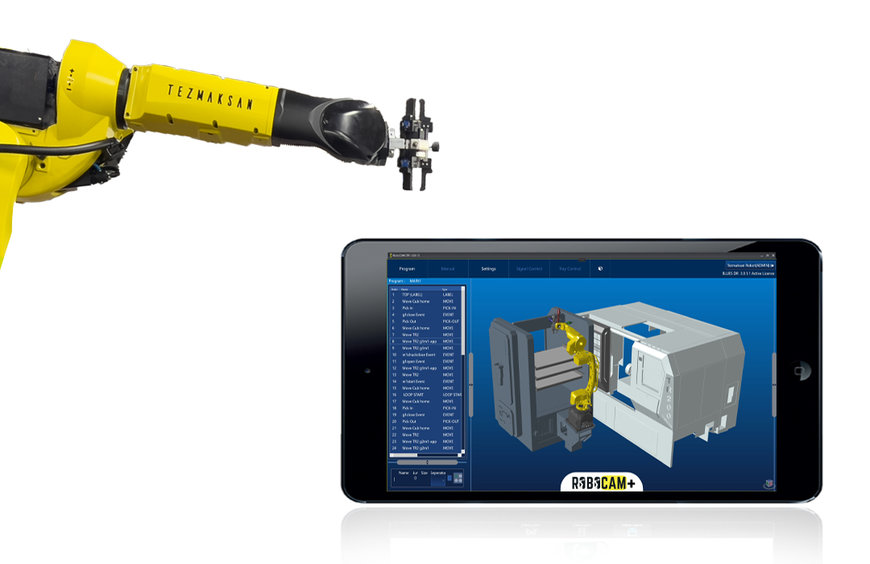Overcoming the complexities of digital transformation
New RoboCAM+ software democratises robot programming.

“Rapid technological advancements, such as artificial intelligence (AI), automation and digital transformation are strategic areas of focus for manufacturing,” according to PwC's 2024 Outlook report. However, despite the pressure on manufacturers to achieve success through Industry 4.0, expanding digital transformations across factory networks is challenging and complex. Here, Hakan Aydogdu, general manager of CNC automation system manufacturer, Tezmaksan Robot Technologies, examines how CNC robot programming software can help manufacturers’ digital transformation.
Acquiring new digital technologies and capabilities will be essential if these companies are to stay competitive and expand their market presence, reports PwC. Elsewhere, as reported by McKinsey, “Companies at the front of the pack are capturing benefits across the entire manufacturing value chain — increasing production capacity and reducing material losses, improving customer service and delivery lead times, achieving higher employee satisfaction, and reducing their environmental impact.”
These advantages can transform a company’s competitive standing when scaled across the entire business, yet digitalisation requires significant time and money. McKinsey also reports that most manufacturers, “remain unable to scale successful pilot programs or fully leverage new tools and technology to see meaningful returns.”
Let’s examine the challenges in more depth. First, it can be complex and time-consuming to integrate new Industry 4.0 technologies with existing systems. Second, introducing new technologies into manufacturing processes could disturb existing tried-and-trusted processes and, in doing so, disrupt the supply chain.
More Internet of Things (IoT) technologies on the shop floor also equals a proliferation of connected devices, and increasingly vast amounts of data. Managing these devices and data is becoming more complex, which creates a need for robust data management systems to turn these complexities into profitable actions.
Another potential obstacle to rolling-out digital transformations is the human aspect. Implementing new Industry 4.0 technologies often requires employees to acquire new skills or retrain. In other cases, manufacturers can face challenges in finding and retaining talent with the necessary technical expertise to operate and maintain these new technologies in ways that capture the benefits listed by McKinsey.
There might even be resistance to change on the shop floor, as employees accustomed to traditional methods hinder the adoption of new technologies. How can manufacturers overcome these obstacles, while effectively digitalising their processes to stay competitive? Fortunately, an answer lies in industrial automation software.

Round-the-clock operation
Vendor-agnostic CNC robot programming software platforms can help modernise and simplify the role of robot operators. Such software can significantly reduce time spent instructing the robot and work across all CNC machines and control units of different ages and vendors, as are typically found in manufacturing environments. These advantages can help manufacturers, which might otherwise struggle, successfully scale pilot programs and fully leverage new tools and technology.
One example of this software is RoboCAM+, a program developed by Tezmaksan Robot Technologies, to control and monitor robotic operations. RoboCAM+ was initially developed to control Tezmaksan’s own CubeBOX CNC automation system, a modular solution designed to automate production without human operators.
With RoboCAM+ at its core, the CubeBOX system enables multiple machines to operate seamlessly without interruptions, such as those stemming from loading and unloading processes. Offering round-the-clock operation without the need for constant operator intervention, the primary benefit of the CubeBOX system lies in its ability to work seamlessly and continuously.
However, RoboCAM+ software has evolved into a versatile solution compatible with all types of robotic CNC machines and control units. A key breakthrough achieved with RoboCAM+ is that the software can create 3D models of workpieces. By converting 2D CAD drawings into 3D CAM instructions, RoboCAM+ streamlines the design manufacturing process, significantly reducing the time spent instructing the robot.
This function removes the need for programming and extensive CAM knowledge, as well as the need for specialised training. This eliminates the complexities of robotics programming and makes automation engineering more accessible to individuals with varying levels of programming expertise.
Foremost, this democratisation of robot programming opens access to a wider audience in manufacturing, and training can be delivered more quickly. This also supports effective change management for manufacturers, helping them overcome the challenges and complexities of digital transformation.
www.tezmaksan.com

